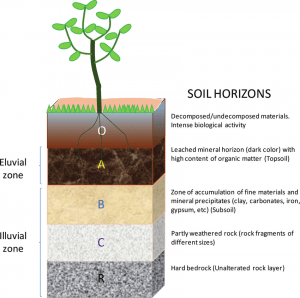Soil Profile
The soil profile is the term used for the vertical section of the earth crust generally up to a depth of 1.83 meters or up to the parent material to show different layers or horizons of soil for the study of the soil in its undisturbed state. It consists of a succession of horizontal layers or horizons, each of which varies in thickness, colour , texture, structure, consistency, porosity, acidity and composition. Pedon is the smallest three-dimensional volume of soil needed to provide a full representation of horizontal soil variability.
In general, soils have four organic or O-horizon horizons and three mineral (A, B , C) horizons. Some workers have recognized the D-horizon, in which rocks are in active weather conditions, between C and R-horizons. R-horizon is the consolidated rock on which the soil profile rests. A and B-horizons are the true soil or solum. Each horizon in the soil profile is further subdivided. Horizon subdivisions are indicated by Arabic numbers, e.g. O1, O2, A1, A2, etc. Different soil-profile horizons have the following characteristics:
- O-horizon: The O-horizon, once designated as L, F, H, or Ao and Ao, is the surface layer formed above the mineral layers and composed of fresh or partially decomposed organic material as found in temperate forest soils. It is usually absent from cultivated soils and grasslands. O-horizon contains both types of humus (e.g. mull and mor) and is subject to the greatest changes in soil temperature and humidity and contains most organic carbon. O-horizon and the upper part of the horizon is the area where life is most abundant. The O horizon is divided into two sub-layers:
(i) O1 (Aoo) region: It is the uppermost layer, consisting of freshly fallen dead leaves , branches, flowers and fruits, dead animal remains, etc. All of these do not show a clear breakdown.
(ii) O2 (Ao) region: Below the O1 region is the O2 layer of partially decomposed organic matter. The process of decomposition of the litter has begun in the O2 region. Organic matter is therefore found at different stages of decomposition and microorganisms such as bacteria , fungi, actinomycetes are frequently found in it. Upper layers contain detritus at the initial stage of decomposition, in which the material can be slightly detected, while the lower layers contain rather decomposed matter, the duff.
- A-horizon: It is characterized by the accumulation of major organic matter, the loss of clay, iron and aluminum, and the development of organo-mineral complexes, granular crumbs or platinum structures. The A-horizon is divided into two sub-layers:
(i) A1 region: This region is dark and rich in organic matter and is known as a humic or melanized region. The amorphous, finely-divided organic matter here is mixed with the mineral matter, now known as humus, which is dark brown or black-coloured.
(ii) A2 region: It is a light-colored region where large-scale mineral particles such as sand (silica) have more than a small amount of organic matter. In areas of heavy rainfall, minerals and organic chemicals are rapidly lost in this region , making it light-coloured. The A2 region is, therefore, also referred to as the podsol or eluvial zone or leaching zone.
- B-horizon: It lies below the A-horizon and is also referred to as sub-soil or illumination or illumination zone, as the nutrients received from the A-horizon due to leaching are accumulated in this region. B-horizon is dark-coloured and rough textured due to the presence of silica rich in clay, organic compounds, hydrated oxides of aluminium , iron, etc. It is not well developed in dry areas. B-horizon can be divided into B1 (A3), B2 and B3 regions, depending on the stage of soil development in the area.
- C-horizon: Below the B-horizon and above the surface of the weathered parent rock, is the regolith or C-horizon zone. It is a light coloured horizon with a weathered parent material.
- R-horizon: Below all these horizons, the R-horizon, which is the parent, may lie unweathered bedrock. The percolated soil water tends to accumulate on the surface of the bedrock.

